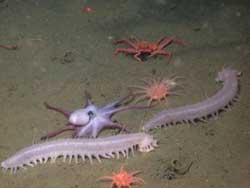New study examines how ocean energy impacts life in the deep sea

This shows assorted invertebrates on the seafloor off of Central California (Tiburon Dive# 606; Lat= 37.4; Lon= -123.3; Depth= 1949.8 m).<br><br>Credit: Courtesy of the Monterey Bay Aquarium Research Institute (MBARI) (c) 2003<br>
A new study of deep-sea species across the globe aims to understand how natural gradients in food and temperature in the dark, frigid waters of the deep sea affect the snails, clams, and other creatures that live there.
Similar studies have been conducted for animals in the shallow oceans, but our understanding of the impact of food and temperature on life in the deep sea — the Earth's largest and most remote ecosystem — has been more limited.
The results will help scientists understand what to expect in the deep sea under future climate change, the researchers say. “Our findings indicate that the deep sea, once thought remote and buffered against climatic change, may function quite differently in the future,” they write.
All living things need energy in the form of food, heat and light to survive, grow, and reproduce. But for life in the deep sea — defined as anything beyond 600 feet (200 m) — energy of any kind is in short supply. Descend more than a few hundred feet beneath the ocean surface, and you'll find a blue-black world of near-freezing temperatures, and little or no light.
Because so little of the sun's light penetrates the surface waters, there are no plants for animals to eat. Most deep-sea animals feed on tiny particles of dead and decaying organic matter drifting down from the sunlit waters above. It is estimated that less than 1% of the food at the surface reaches the ocean's watery depths.
The researchers wanted to know what this energy deprivation means for deep sea habitats across the globe, and for the animals that live there. “How much of the differences that we see across different groups of deep-sea animals in terms of growth, or lifespan, or the number of species, are related to differences in the temperature or amount of food where they occur?” said co-author Craig McClain of the National Evolutionary Synthesis Center in Durham, North Carolina.
To find out, the researchers compiled previously published data for hundreds of deep-sea species across the globe, ranging from crabs and snails to fish and tube worms. The data included parameters like metabolic rate, lifespan, growth, biomass, abundance, size and diversity.
The results suggest that the relative importance of the two basic forms of energy available in the deep sea — food and warmth — vary considerably, said co-author Michael Rex at the University of Massachusetts in Boston.
Temperature has the biggest impact on parameters at the individual level, such as metabolism and growth rate. For example, deep sea animals living in warmer waters tend to have faster metabolisms.
But for higher-level parameters such as abundance or species diversity, food is more important. Generally speaking, food-rich areas tend to have animals that are bigger, more abundant and more diverse.
The results add to the growing body of evidence that the deep sea isn't isolated from the effects of climate change, the researchers say.
“The oceans are getting warmer and they're producing less food,” McClain said. Warmer water in the deep sea due to climate change could mean faster growth and metabolism for the animals that live there, but that could be bad news if the oceans produce less food to support them.
“The news is not good,” Rex added. “Changes in temperature and food availability associated with climate change could cause widespread extinction in the deep ocean if environmental changes occur faster than deep-sea organisms can respond by shifting their ranges or adapting to new conditions.”
The study was published online in the September 4, 2012 issue of Proceedings of the National Academy of Sciences.
Other authors of the study were Andrew Allen of Macquarie University in Australia, and Derek Tittensor of the United Nations Environment Programme World Conservation Monitoring Centre in the United Kingdom.
CITATION: McClain, C., A. Allen, et al. (2012). “The energetics of life on the deep sea floor.” PNAS. http://dx.doi.org/10.1073/pnas.1208976109
The National Evolutionary Synthesis Center (NESCent) is a nonprofit science center dedicated to cross-disciplinary research in evolution. Funded by the National Science Foundation, NESCent is jointly operated by Duke University, The University of North Carolina at Chapel Hill, and North Carolina State University. For more information about research and training opportunities at NESCent, visit www.nescent.org.
Media Contact
More Information:
http://www.nescent.orgAll latest news from the category: Ecology, The Environment and Conservation
This complex theme deals primarily with interactions between organisms and the environmental factors that impact them, but to a greater extent between individual inanimate environmental factors.
innovations-report offers informative reports and articles on topics such as climate protection, landscape conservation, ecological systems, wildlife and nature parks and ecosystem efficiency and balance.
Newest articles

High-energy-density aqueous battery based on halogen multi-electron transfer
Traditional non-aqueous lithium-ion batteries have a high energy density, but their safety is compromised due to the flammable organic electrolytes they utilize. Aqueous batteries use water as the solvent for…

First-ever combined heart pump and pig kidney transplant
…gives new hope to patient with terminal illness. Surgeons at NYU Langone Health performed the first-ever combined mechanical heart pump and gene-edited pig kidney transplant surgery in a 54-year-old woman…

Biophysics: Testing how well biomarkers work
LMU researchers have developed a method to determine how reliably target proteins can be labeled using super-resolution fluorescence microscopy. Modern microscopy techniques make it possible to examine the inner workings…





















